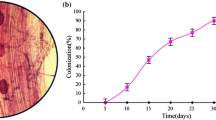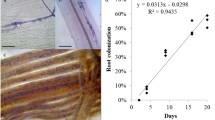Abstract
The pre-symbiotic phase that precedes physical contact between symbionts is a crucial phase in determining their compatibility, allowing the formation of the ectomycorrhiza. A subtractive cDNA library representing the differentially expressed genes of the fungus Hydnangium sp. in the pre-symbiotic phase was constructed using fungal mycelia obtained through the in vitro mycorrhization technique. The fungus was cultured in the presence of Eucalyptus grandis roots, but with no contact between the hyphae and the root system of the host plant. Genes that code for proteins related to carbohydrate, amino acid, and energy metabolisms, transcription, and protein synthesis, cellular communication, signal transduction, stress response, transposons, and proteins related to the biogenesis of cell components were identified among the 131 expressed sequence tags. Expression of the genes that code for acetyl-CoA acetyltransferase, pyruvate dehydrogenase, ATP synthase, a voltage-dependent protein from the selective ion channel, and hydrophobin was evaluated by the RT-qPCR technique, confirming the activation of these genes in this phase of the association.



Similar content being viewed by others
References
Acioli-Santos B, Sebastiana M, Pessoa F, Sousa L, Figueiredo A, Fortes AM, Baldé A, Maia L, Pais M (2008) Fungal transcript pattern during the preinfection stage (12 h) of ectomycorrhiza formed between Pisolithus tinctorius and Castanea sativa roots, identified using cDNA microarrays. Curr Microbiol 57:620–625. doi:10.1007/s00284-008-9253-2
Altschul SF, Madden TL, Schaffer AA, Zhang J, Zhang Z, Miller W, Lipman DJ (1997) Gapped BLAST and PSI-BLAST: a new generation of protein database search programs. Nucleic Acids Res 25:3389–3402. doi:10.1093/nar/25.17.3389
Burgess T, Dell B, Malajczuk N (1996) In vitro synthesis of Pisolithus-Eucalyptus ectomycorrhizae: synchronization of lateral tip emergence and ectomycorrhizal development. Mycorrhiza 6:189–196. doi:10.1007/s005720050125
Campos DTS (2004) Diversidade de fungos ectomicorrízicos em povoamentos de eucalipto. Thesis, Federal University of Viçosa
Chu-Chou M, Grace LJ (1983) Hypogeous fungi associated with some forest trees in New Zealand. N Z J Bot 21:183–190
Diatchenko L, Lau YF, Campbell AP, Chenchik A, Moqadam F, Huang B, Lukyanov S, Lukyanov K, Gurskaya N, Sverdlov ED, Siebert PD (1996) Suppression subtractive hybridization: a method for generating differentially regulated or tissue-specific cDNA probes and libraries. Proc Natl Acad Sci USA 93:6025–6030. doi:10.1073/pnas.93.12.6025
Duplessis S, Courty PE, Tagu D, Martin F (2005) Transcript patterns associated with ectomycorrhiza development in Eucalyptus globulus and Pisolithus microcarpus. New Phytol 165:599–611. doi:10.1111/j.1469-8137.2004.01248.x
Frettinger P, Derory J, Herrmann S, Plomion C, Lapeyrie F, Oelmüller R, Martin F, Buscot F (2007) Transcriptional changes in two types of pre-mycorrhizal roots and in ectomycorrhizas of oak microcuttings inoculated with Piloderma croceum. Planta 225:331–340. doi:10.1007/s00425-006-0355-4
Heller G, Adomas A, Li G, Osborne J, Van Zyl L, Sederoff R, Finlay RD, Stenlid J, Asiegbu FO (2008) Transcriptional analysis of Pinus sylvestris roots challenged with the ectomycorrhizal fungus Laccaria bicolor. BMC Plant Biology 8:19–32. doi:10.1186/1471-2229-8-19
Hiremath ST, Balasubramanian S, Zheng J, Podila GK (2006) Symbiosis-regulated expression of an acetylCoA acetyltransferase gene in the ectomycorrhizal fungus Laccaria bicolor. Can J Bot 84:1405–1416
Inoue H, Nojima H, Okayama H (1990) High efficiency transformation of Escherichia coli with plasmids. Gene 96:23–28. doi:10.1016/0378-1119(90)90336-P
Kim SJ, Bernreuther D, Thumm M, Podila GK (1999) LB-AUT7, a novel symbiosis-regulated gene from an ectomycorrhizal fungus, Laccaria bicolor, is functionally related to vesicular transport and autophagocytosis. J Bacteriol 181:1963–1967
Krüger A, Peskan-Berghöfer T, Frettinger P, Herrmann S, Buscot F, Oelmüller R (2004) Identification of premycorrhiza-related plant genes in the association between Quercus robur and Piloderma croceum. New Phytol 163:149–157. doi:10.1111/j.1469-8137.2004.01091.x
Laurent P, Voiblet C, Tagu D, De Carvalho D, Nehls U, De Bellis R, Balestrini R, Bauw G, Bonfante P, Martin F (1999) A novel class of ectomycorrhiza-regulated cell wall polypeptides in Pisolithus tinctorius. Mol Plant-Microbe Interact 12:862–871. doi:10.1094/MPMI.1999.12.10.862
Le Quéré A, Wright D, Söderström B, Tunlid A, Johansson T (2005) Global patterns of gene regulation associated with the development of ectomycorrhiza between birch (Betula pendula Roth.) and Paxillus involutus (Batsch) Fr. Mol Plant-Microb Interact 18:659–673. doi:10.1094/MPMI-18-0659
Malajczuck N, Hartney VL (1986) Procedure for inoculation of micropropagated plantlets of Eucalyptus camaldulensis whith ectomycorrhizal fungi and comparison with seedling inoculation using inoculum contained in a peat/vermiculite carrier. Aust For Res 16:199–206
Malajczuk N, Molina R, Trappe JM (1982) Ectomycorrhiza formation in Eucalyptus: pure culture synthesis, host specificity and mycorrhizal compatibility with Pinus radiate. New Phytol 91:467–482. doi:10.1111/j.1469-8137.1982.tb03325.x
Martin F, Kohler A, Duplessis S (2007) Living in harmony in the wood underground: ectomycorrhizal genomics. Curr Opin Plant Biol 10:204–210. doi:10.1016/j.pbi.2007.01.006
Martin F, Aerts A, Ahrén D, Brun A, Duchaussoy F, Gibon J, Kohler A, Lindquist E, Pereda V, Salamov A, Shapiro HJ, Wuyts J, Blaudez D, Buée M, Brokstein P, Canbäck B, Cohen D, Courty PE, Coutinho P, Danchin EGJ, Delaruelle C, Detter J, Deveau A, Difazio S, Duplessis S, Fraissinet-Tachet L, Lucic E, Frey-Klett P, Fourrey C, Feussner I, Gay G, Gérard J, Grimwood J, Hoegger PJ, Jain P, Kilaru S, Labbé J, Lin YC, Legué V, Letacon F, Marmeisse R, Melayah D, Montanini B, Muratet M, Nehls U, Niculita-Hirzel H, Oudot-Lesecq MP, Peter G, Quesneville H, Rajashekar B, Reich M, Rouhier N, Schmutz J, Yin T, Chalot M, Henrissat B, Kües U, Lucas S, Van De Peer Y, Podila G, Polle A, Pukkila PJ, Richardson P, Rouzé P, Sanders I, Stajich JE, Tunlid A, Tuskan G, Grigoriev I (2008) The genome of Laccaria bicolor provides insights into mycorrhizal symbiosis. Nature 452:88–92. doi:10.1038/nature06556
Marx DH (1969) The influence of ectotropic mycorrhizal fungi on the resisteance if pine roots to pathogenic fungi and soil bacteria. Phytopathology 59:153–163
Melin P, Schnürer J, Wagner EGH (2002) Proteome analysis of Aspergillus nidulans reveals proteins associated with the response to the antibiotic concanamycin A, produced by Streptomyces species. Mol Genet Genom 267:695–702. doi:10.1007/s00438-002-0695-0
Menotta M, Amicucci A, Sisti D, Gioacchini AM, Stocchi V (2004) Differential gene expression during pre-symbiotic interaction between Tuber borchii Vitad. and Tilia americana L. Curr Genet 46:158–165
Morel M, Jacob C, Kohler A, Johansson T, Martin F, Chalot M, Brun A (2005) Identification of genes differentially expressed in extraradical mycelium and ectomycorrhizal roots during Paxillus involutus- Betula pendula ectomycorrhizal symbiosis. Appl Environ Microbiol 71:382–391. doi:10.1128/AEM.71.1.382-391.2005
Peter M, Courty PE, Kohler A, Delaruelle C, Martin D, Tagu D, Frey-Klett P, Duplessis S, Chalot M, Podila G, Martin F (2003) Analysis of expressed sequence tags from the ectomycorrhizal basidiomycetes Laccaria bicolor and Pisolithus microcarpus. New Phytol 159:17–129. doi:10.1046/j.1469-8137.2003.00796.x
Podila GK, Zheng J, Balasubramanian S, Sundaram S, Hiremath S, Brand J, Hymes M (2002) Molecular interactions in ectomycorrhizas: identification of fungal genes involved in early symbiotic interactions between Laccaria bicolor and red pine. Plant and Soil 244:117–128
Prins TW, Wagemakers L, Van Kan JAL (2000) Structure and expression in planta of Botrytis cinerea ubiquitin genes. Eur J Plant Pathol 106:693–698
Sambrook J, Fritsch EF, Maniatis T (1989) Molecular cloning: a laboratory manual. Cold Spring Harbor Laboratory, New York
Sanger F, Nicklen S, CoulsoN AR (1977) DNA sequencing with chain-terminating inhibitors. Proc Natl Acad Sci USA 74:5463–5467. doi:10.1073/pnas.74.12.5463
Smith SE, Read DJ (1997) Mycorrhizal symbiosis. Academy, New York, 605p
Tagu D, Nasse B, Martin F (1996) Cloning and characterization of hydrophobins-encoding cDNAs from the ectomycorrhizal basidiomycete Pisolithus tinctorius. Gene 168:93–97. doi:10.1016/0378-1119(95)00725-3
Tagu D, Lapeyrie F, Martin F (2002) The ectomycorrhizal symbiosis: genetics and development. Plant Soil 244:97–105
Voiblet C, Duplessis S, Encelot N, Martin F (2001) Identification of symbiosis-regulated genes in Eucalyptus globulus-Pisolithus tinctorius ectomycorrhiza by differential hybridization of arrayed cDNAs. Plant J 25:1–12. doi:10.1046/j.1365-313x.2001.00953.x
Zaretsky M, Sitrit Y, Mills D, Roth-Bejerano N, Kagan-Zur V (2006) Differential expression of fungal genes at preinfection and mycorrhiza establishment between Terfezia boudieri isolates and Cistus incanus hairy root clones. New Phytol 171:837–846. doi:10.1111/j.1469-8137.2006.01791.x
Acknowledgements
We thank FAPEMIG and CNPq (Brazilian Institutions) for the financial support.
Author information
Authors and Affiliations
Corresponding author
Rights and permissions
About this article
Cite this article
da Silva Coelho, I., de Queiroz, M.V., Costa, M.D. et al. Identification of differentially expressed genes of the fungus Hydnangium sp. during the pre-symbiotic phase of the ectomycorrhizal association with Eucalyptus grandis . Mycorrhiza 20, 531–540 (2010). https://doi.org/10.1007/s00572-010-0301-y
Received:
Accepted:
Published:
Issue Date:
DOI: https://doi.org/10.1007/s00572-010-0301-y




